 |
|
|
|
|
|
|
|
|
|
|
|
||
|
|
|
||
May 1998
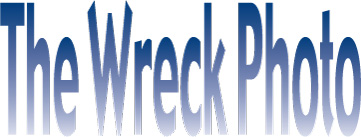
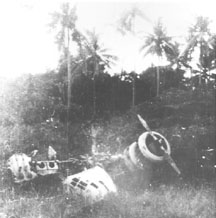
We asked, “Is This Earhart’s Electra?” and offered a prediction:
“The photograph on this page has already stirred up quite a bit of controversy and will probably stir up more.”
That bit of prophecy has certainly come true. Now known generally as “the wreck photo,” there is no shortage of opinion about what it might be, what it definitely is and what it definitely is not. Unfortunately, like a Rorschach inkblot, different people see different things. Some see a Lockheed 10. Some see anything but a Lockheed 10. Some see another type of aircraft. Some see a jumble of parts from several types. A guy in a gorilla suit has even been seen in the background. What’s the truth? Is it even possible to know for sure? And what difference does it make anyway?
There is no way for a single photograph to stand as absolute proof of anything except its own existence. The possibility of an undetected forgery is always present. However, if a scientifically sound identification can be made; and if there is good reason to believe that the airplane in the photo is NR16020, then the photo is, at the very least, a compelling clue that the Earhart aircraft did not sink at sea. If the photo shows the wave battered wreck of AE’s Electra washed up into the treeline on the shore of a Pacific atoll, it is startling corroboration of the anecdotal accounts of just such a wreck related by former residents of Nikumaroro and a significant guide as to how we should construct our search effort for the Niku IIII expedition. So, yes, it does make a difference and it’s worth trying to figure out what we can about the photo.
To make a scientifically defensible identification of the aircraft in the photo requires that we remove from the process, to whatever degree is possible, the element of opinion. If we rely upon individual judgements of whether, for example, the nose section looks too wide or too short to be this or that, we are doomed to wallow in controversy. If, instead, we quantify the elements visible in the photo and compare them to objects or features of known identity, we can then say with some certainty that this thing is just like this thing and they are probably, therefore, the same sort of thing. Conversely, we can say that this thing is not like this thing, so they are probably different things.
It is, in fact, possible to set some very conservative requirements for any aircraft type to be considered as a candidate for the mystery plane. It must:
- Be of stressed aluminum construction.
- Be multi-engined (probably twin).
- Have two bladed, Hamilton Standard (or Hamilton Standard-type) propellers.
- Have adjustable pitch or constant speed propellers.
- Not have full-feathering propellers (with domed hubs).
- Have cowlings capable of coming apart, either by design or by failure, in such a way as to leave only a ring cowl present.
- Feature a nose section constructed of four transverse bulkheads ahead of the windshield.
- Have a windshield with a single prominent centerpost.
- Have a rim of raised aluminum along the base of the windshield.
- Have panels behind the inboard wing leading edges which feature two large lightening holes.
Surprisingly few candidates even come close to these requirements. In addition to the Lockheed Model 10, suggested alternates include:
Beechcraft Model 18 |
 Grumman Goose |
 Tachikawa Ki-54 |
 Lockheed 12 “Baby Electra” |
Of these, the Beech, and Lockheed 12 have windshields that are inconsistent with the photo and the long nose of the Goose has a hatch that is not present in the photo. The Tachikawa seems a better candidate but structural information is harder to come by. Research continues.
Perhaps the most important quantification of the airplane in the photo centers upon the relative proportions of the propeller and the cowling of the left-hand engine. Because we have nothing in the photo of known dimension, it is not possible to establish a definitive scale. However, it is possible to establish whether or not the proportions measurable in the photo are right for various types of aircraft. We naturally decided to start with the Lockheed Model 10.
The first step was getting accurate propeller and cowling dimensions. The propeller was easy. With original Lockheed records, and the help of Jim Cook (TIGHAR #2072) at Hamilton Standard in Windsor Locks, Connecticut, we were able to document that all Model 10As (with Pratt & Whitney 450 hp R985 engines) and 10Es (with P&W 550 hp R1340 engines) had Hamilton Standard props exactly nine feet in length. Cowling dimensions for the Model 10A were measured directly from Lockheed 10A constructor’s number (c/n) 1052 at the New England Air Museum, also in Windsor Locks (Earhart’s 10E Special was c/n 1055). Cowling dimensions for the Model 10E, with the larger R1340 engines, proved to be much harder to establish. Only one genuine 10E still exists – c/n 1042. It is now under rebuild in New Jersey, but the owner will not permit access to the aircraft. A converted 10A, c/n 1015, which was modified to resemble NR16020 for a 1997 promotional recreation of Earhart’s flight, has the big engines but the cowlings are not correct (they’re actually for the North American AT-6).
While we were trying to find an authentic 10E cowling to measure, Jeff Glickman of Photek, Inc. in Hood River, Oregon went ahead with the hi-tech forensic work on the photo. Here’s an excerpt from Jeff’s preliminary report in September 1997:
The Lockheed 10 uses a 9 foot prop which was used as a scale in the analysis of this photograph. Because the propeller has roll, pitch and yaw relative to the film plane (i.e. relative to the observer), there is an oblique projection of the propeller on to the film plane in all 3 dimensions. This results in "foreshortening" of the propeller on the image plane, hence the apparent length of the propeller in the photograph is not constant­p;it is longer at one end and shorter at the other end. The variation as measured from the photograph from the lower right corner of the propeller is approximately 8%. 6.87 pixels per inch is the mean sampling rate in the upper portion of the propeller while 6.61 pixels per inch in the mean sampling rate for the lower portion of the propeller. A linear model was employed for estimating the sampling rates at the ends of the propeller which resulted in 7.0 pixels per inch at the upper left end of the propeller and 6.48 pixels per inch at the lower right end of the propeller.
The lengths of the upper and lower portions of the propeller were measured multiple times to establish the projected lengths. The mean values were used for computation and the variance used to establish error bounds. The center of the probable error band for measurement error in the length of the propeller is 1.13 inches. Repeated measurements of the engine diameter yielded a mean diameter of 54 inches with a probable error band of 1.34 inches.
Because the Lockheed Electra 10A has an engine diameter of 46.34 inches, these results exclude the possibility that the airplane in the wreck is a 10A.
Jeff Glickman
Board Certified Forensic Examiner
If the airplane in the photo can not be a 10A, that would also seem to exclude other types which use the nine foot prop and the 450 hp R985 engine (i.e. the Beech 18 and the Lockheed 12). But what about the Lockheed 10E? Did it have a cowling diameter within 1.34 inches of 54 inches? If not, we could forget about the wreck photo. But where could we get our hands on an authentic 10E cowling to measure?
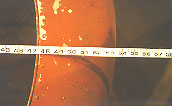 The
answer came, quite unexpectedly, during a visit to the National Museum of
Naval Aviation in Pensacola, Florida to examine a sextant in their collection
(see The Noonan Project). In storage
at the museum is yet another NR16020 wannabe. C/N 1130 is a late production
10A which was approaching completion of an extensive rebuild as an Earhart
look-alike when the project, funded by a private foundation, ground to a
stop. Until the problems were resolved, the Navy agreed to provide storage
space. Invited to inspect the project, we noticed some old, used cowlings
lying on the floor. Upon closer inspection we noted markings that read “Lockheed
10E cowl, P&W 1340.” Where they came from is anybody’s guess,
but we didn’t much care. We measured the diameter of the assembled
cowling and got 53.5 inches – easily within the 1.34 inch error band for
the 54 inch cowl in the wreck photo.
The
answer came, quite unexpectedly, during a visit to the National Museum of
Naval Aviation in Pensacola, Florida to examine a sextant in their collection
(see The Noonan Project). In storage
at the museum is yet another NR16020 wannabe. C/N 1130 is a late production
10A which was approaching completion of an extensive rebuild as an Earhart
look-alike when the project, funded by a private foundation, ground to a
stop. Until the problems were resolved, the Navy agreed to provide storage
space. Invited to inspect the project, we noticed some old, used cowlings
lying on the floor. Upon closer inspection we noted markings that read “Lockheed
10E cowl, P&W 1340.” Where they came from is anybody’s guess,
but we didn’t much care. We measured the diameter of the assembled
cowling and got 53.5 inches – easily within the 1.34 inch error band for
the 54 inch cowl in the wreck photo.
Whatever the identity of the plane in the wreck photo, its prop and engine cowling have the same proportions as a Lockheed 10E: this thing is just like this thing and they are probably, therefore, the same sort of thing.
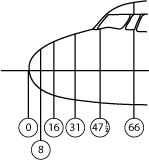 But what about the nose section? At least two researchers have pointed
out that while the nose in the wreck photo has the correct number of bulkheads
for the Lockheed Model 10, there seems to be a problem with the spacing between
them. The nose of the Electra has a cone at the tip which opens as a door.
Immediately behind that is a bulkhead at Station 8 (that is, eight inches
from the tip of the nose). There is another bulkhead at Station 16, followed
by a bulkhead at Station 31and another at Station 47 1/2. Starting from Station
8, the spacing between bulkheads in the nose of the Lockheed 10 is, therefore,
8 inches, 15 inches, and 16.5 inches. The spacing between bulkheads in the
wreck photo nose, on the other hand, appears to be quite even.
But what about the nose section? At least two researchers have pointed
out that while the nose in the wreck photo has the correct number of bulkheads
for the Lockheed Model 10, there seems to be a problem with the spacing between
them. The nose of the Electra has a cone at the tip which opens as a door.
Immediately behind that is a bulkhead at Station 8 (that is, eight inches
from the tip of the nose). There is another bulkhead at Station 16, followed
by a bulkhead at Station 31and another at Station 47 1/2. Starting from Station
8, the spacing between bulkheads in the nose of the Lockheed 10 is, therefore,
8 inches, 15 inches, and 16.5 inches. The spacing between bulkheads in the
wreck photo nose, on the other hand, appears to be quite even.
Is this apparent discrepancy a disqualifier? Maybe, maybe not. Simply laying a ruler on the photo doesn’t correct for viewing angle and possible distortion, either photographic or physical. More computer time and calculations are called for.
Another feature in the photo that matches the Lockheed 10 is the presence of a panel with two large lightening holes directly behind the leading edge of the inboard wing. This is not the wing spar but merely a piece of sheet aluminum. Just how unique to the Electra this structure is has yet to be determined.
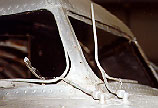
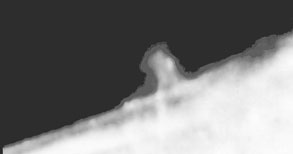 One of the most interesting details to come out of the forensic anlysis
of the wreck photo is the shape of the base of the windshield centerpost.
Rather than the straight bar featured in many aircraft types, this centerpost
has a sweeping curve at its base which appears to be more stylistic than
strictly functional. The feel is almost art deco. A close look at the base
of the broken-off centerpost in the wreck photo reveals that same shape.
One of the most interesting details to come out of the forensic anlysis
of the wreck photo is the shape of the base of the windshield centerpost.
Rather than the straight bar featured in many aircraft types, this centerpost
has a sweeping curve at its base which appears to be more stylistic than
strictly functional. The feel is almost art deco. A close look at the base
of the broken-off centerpost in the wreck photo reveals that same shape.
As interesting as the question of the airplane’s identity is the puzzle of how it came to look the way it does. A few facts are apparent:
- Much of the airplane is missing. The entire cabin from the cockpit roof aft is gone. The starboard engine and accessories from the firewall forward appear to have been ripped forward from the mounts with great force. The port engine, by contrast, is relatively intact and the propeller unbent.
- The airplane did not crash but was landed with at least the left, and probably the right main gear legs extended. The damage apparent in the photo is, therefore, not the result of the landing but of some subsequent catastrophic event.
- The only clear signs of human activity are the removal of some rectangular pieces of skin from the nose and the splitting and peeling open of the inboard leading edge on the starboard side. It is difficult to imagine how these failures might occur from natural forces.
- There are no people in the photo.
- The wreck has lain in this location long enough for some plants to grow up through it. Whether somone has cleared away other vegetation before taking the photo is impossible to say.
- The only impact damage apparent is low on the right-hand side of the nose section. Here, computer enhancement of the image reveals that the skin has been pushed inward, but the underlying structure remains intact. This suggests the impact of a strong fluid force against the relatively stationary object (i.e. wave damage).
The possibility that the aircraft in the photo was beaten by large waves or surf may account for other aspects of its appearance. Tons of moving water might well have carried off the upper portion of the cabin, and an airplane driven backward might leave behind an engine that snagged on something immovable. The force of water might also explain the puzzle of the ring cowl.
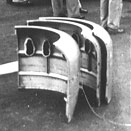
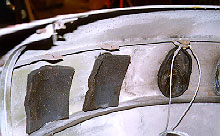 The
cowlings of most Lockheed 10s, including Earhart’s, came off in three
equal 120 degree sections. Their normal removal would not result in the ring
cowl being left behind as is seen in the wreck photo. Some aircraft do use
a fixed ring cowl, but none fit the other requirements of the plane in the
photo. (We don’t yet know about the Tachikawa Ki-54.) The Lockheed
10E cowl is affixed to the airframe by means of a steel cable which passes
through metal clips on the inside of the cowling and encircles the engine
just forward of the valve covers (see photo at left). When secured, the cable
attaches the forward part of the cowling (the ring cowl) very firmly to the
engine. The after portions of the cowl, not being subject to direct air pressure,
are very lightly attached. Should the engine compartment be engulfed with
water, as in the airplane being struck from behind by a big wave, it’s
not hard to imagine that the only portion of the cowling that would remain
intact might be the firmly attached ring cowl.
The
cowlings of most Lockheed 10s, including Earhart’s, came off in three
equal 120 degree sections. Their normal removal would not result in the ring
cowl being left behind as is seen in the wreck photo. Some aircraft do use
a fixed ring cowl, but none fit the other requirements of the plane in the
photo. (We don’t yet know about the Tachikawa Ki-54.) The Lockheed
10E cowl is affixed to the airframe by means of a steel cable which passes
through metal clips on the inside of the cowling and encircles the engine
just forward of the valve covers (see photo at left). When secured, the cable
attaches the forward part of the cowling (the ring cowl) very firmly to the
engine. The after portions of the cowl, not being subject to direct air pressure,
are very lightly attached. Should the engine compartment be engulfed with
water, as in the airplane being struck from behind by a big wave, it’s
not hard to imagine that the only portion of the cowling that would remain
intact might be the firmly attached ring cowl.
Perhaps there is another explanation for the wreck photo. Perhaps there is an aircraft type that fits what can be seen better than does the Lockheed 10E. But for the moment, the wreck photo remains an enticing, if still unresolved, piece of evidence.
